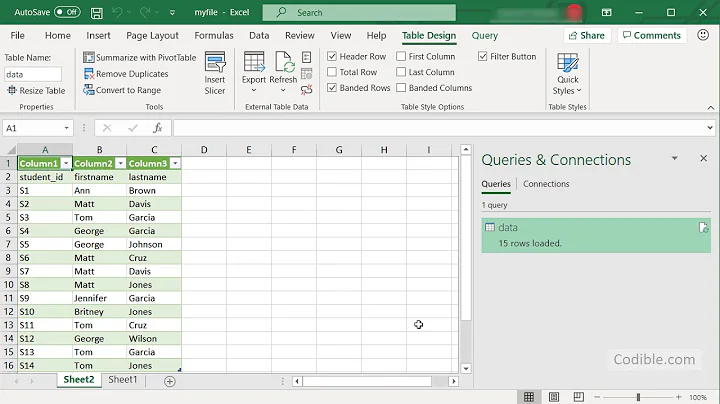Adding a Column of values in a tab delimited file
Solution 1
You can use a one-liner loop like this:
for f in file1 file2 file3; do sed -i "s/$/\t$f/" $f; done
For each file in the list, this will use sed to append to the end of each line a tab and the filename.
Explanation:
- Using the
-iflag withsedto perform a replacement in-place, overwriting the file - Perform a substitution with
s/PATTERN/REPLACEMENT/. In this example PATTERN is$, the end of the line, and REPLACEMENT is\t(= a TAB), and$fis the filename, from the loop variable. Thes///command is within double-quotes so that the shell can expand variables.
Solution 2
Come on why you guys recommend those powerful tools when there's paste command!
$ cat a
A
B
C
D
$ cat b
1
2
3
4
$ paste a b
A 1
B 2
C 3
D 4
With a little trickery, you could use paste for the OP's purpose. However, it will not replace the files inplace:
for f in file1 file2 file3; do
paste $f <(yes $f | head -n $(cat $f | wc -l)) > $f.new
done
This will paste the respective filename as the last column of each file into new file filename.new
Solution 3
You can use awk:
awk '{print $0, FILENAME}' file1 file2 file3 ...
Related videos on Youtube
Ron
Updated on September 18, 2022Comments
-
Ron over 1 year
How can I add a Column of values in a file which has a certain number of rows. I have a input file like this:
Input file:
SPATA17 1 217947738 LYPLAL1 1 219383905 FAM47E 4 77192838 SHROOM3 4 77660162 SHROOM3 4 77660731 SHROOM3 4 77662248Output file:
SPATA17 1 217947738 file1 LYPLAL1 1 219383905 file1 FAM47E 4 77192838 file1 SHROOM3 4 77660162 file1 SHROOM3 4 77660731 file1 SHROOM3 4 77662248 file1In this case, I want to add a Column of values, upto the number of rows in the file.The value remains consistent, such as "file1".
The reason is I have 100 of those files.I don't want to open each file and paste a column. Also is there any way to automate this, by going in a directory and adding a column of values. The value comes from the filename, which has to be added in each row of the file in the last/first column.
-
cuonglm about 10 yearsNo,
FILENAMEis a variable inawk, it expand to current file name thatawkis processing. You just do it one, feed all files toawk. -
Ron about 10 yearsok,but how to direct the output into a new file, of each file?does awk stores the each file while processing?
-
cuonglm about 10 yearsIf you have
GNU awk 4.1.0or later, you can use-ito edit inplace. Otherwise, you should redirectawkouput to a temp file, then usegrepto extract line from each files. -
Ron about 10 yearsThe code works.Can you explain the contents within quotes?
-
Ron about 10 yearsJust as "awk" is used while working with columns, is 'sed' also used for similar situations.I am newbie to 'awk' and 'sed'.
-
 janos about 10 years@Ron
janos about 10 years@Ronsedis most practical for pattern substitution and saving in-place. For your requirement of saving the file it was a relatively convenient option. If you don't need to write back to the same file you're processing, thenawkis usually much easier to work with. -
 fedorqui about 10 yearsWell you can do
fedorqui about 10 yearsWell you can dofor file in *; do awk 'BEGIN{OFS="\t"}{print $0, FILENAME}' $file; done -
user5359531 over 7 yearsPersonally, I get tripped up by
awk's input/output field separators too often, and so try to avoid using it whenever possible, makingsedmore appealing. -
 fachexot over 5 yearsThanks!
fachexot over 5 yearsThanks!pasteis surely a hidden gem.




